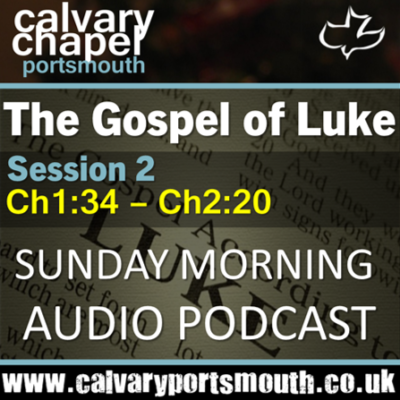This second study in our verse-by-verse journey through the Gospel of Luke was given by pastor Barry Forder at Calvary Portsmouth on 16th October 2022.
CHAPTER 1:34-80
In this session we see both the birth of John and the birth of Jesus recorded. Luke tells how Gabriel had visited Mary to announce that she was to carry and give birth to the long awaited Messiah of Israel, the promised ‘Seed of the woman’ prophesied in genesis 3:15. In humility and faith – and no doubt a little overwhelmed – Mary accepts this awesome responsibility, and then proceeds to go ‘with haste’ to visit her cousin Elizabeth, whom Gabriel had said was now six months pregnant. Upon her arrival, the unborn 26 week old child in Elizabeth’s womb jumps with joy – showing that an unborn child in the womb can experience emotion! In England, Scotland and Wales, you can legally have an abortion up to 23 weeks and 6 days of pregnancy, in line with the Abortion Act 1967.
After staying to celebrate the birth, Mary returns home from the hills around Jerusalem (where Zacharias and Elizabeth lived) to her home in Nazareth. However, before she left she would have heard Zacharias, through the inspiration of the Holy Spirit, declare that the baby Mary was carrying would be the One to redeem His people Israel, in accordance with the prophecies and promises made to Abraham, Isaac and Jacob; to Samuel, David and Solomon; to Isaiah, Jeremiah and Daniel. God’s covenant with Israel was clearly not forgotten, and though they had been disobedient as a nation and followed after other gods, their God was gracious and merciful and through their Messiah would make a way for, not only Gentiles, but also for the ‘lost sheep of the house of Israel’ to return to Him and serve Him as their God.
As we noted in our study, John was most likely born on 19th-20th April 2 B.C., (there are a number of markers that help us pinpoint this date) which would have been the Feast of Passover that year! How fitting that the one who would later announce Jesus as ‘the Lamb of God who takes away the sins of the world’ would be born – and celebrate his birthday each year – when the Passover lambs were being offered as an atonement for sin. It makes John’s announcement of Jesus even more poignant.
If this is so, Jesus’ birth would have occurred, not on the 25th December as tradition would have us believe, but on the 29th September 2 B.C. – which ‘just so happened’ to be the Feast of Trumpets! In the Bible we note that:
–Trumpets were blown to announce war or proclaim joy! – the birth of Christ was both of these, war on the Devil and works of darkness, but joy to the world and those who would put their faith and trust in Him for Salvation!
–The feast of Trumpets required an offering made by fire to the LORD – Jesus was this!
–Zacharias specifically links the trumpet (ram’s horn) – to the birth of Christ Lk 1:69
–The trumpet was linked to the giving of the Word of God at Mt Sinai Ex 19:19 – now the Word made flesh was given to the world
–The trumpet was used to proclaim liberty Lev 25:9 – the greatest liberty, the greatest freedom of all, is found in Jesus Christ!
This demonstrates once again that God is in complete control of history and nothing happens that is not part of His plan or design.
CHAPTER 2:1-20
As we move into chapter 2, the critics of the Bible, and Luke’s Gospel in particular, get ever so excited! You see, they tell us Luke is in error in his opening statement of chapter 2. That apparently means his entire Gospel is untrustworthy, or so they would have us believe. The truth of the matter is that it’s the critics themselves who are in error – once again! It is the Gospel of Luke and his account of these things that is correct.
The contention is this. Luke states that Cyrenius was the govenor of Syria when Caesar Augustus ordered the census that resulted in Mary and Joseph traveling to their ancestral home of Bethlehem. The Jewish historian Josephus, who wrote in around 97 A.D. (some 100 years later), stated that it was an individual by the name of Sabinus who was the then governor of Syria, and that Quirinius (Cyrenius) was in fact the governor during the next census that occurred, but that wasn’t until 6 A.D. Luke we are assured got it all wrong!
As Dr Bill Cooper comments:
- This is indeed a serious problem until we realise the plain and simple fact that Sabinus and Quirinius were one and the same person! Josephus himself tells us as much, albeit obliquely, though it is Suetonius and Tacitus who give us the real clue by telling us Quirinius’ birthplace…
- “Quirinius’ birthplace, which the critics have always remained silent about, was the Italian town of Lanuvium. It lies about 20 miles or so along the Appian Way to the southeast of Rome, and was inhabited by a Sabine population, the Sabines being an Italian tribe. Hence, Quirinius was himself of Sabine descent.”
- “..it is the inability of Josephus and the critics to distinguish between his sources and not any chicanery on Luke’s part which has caused all the confusion over the two recorded censuses of Judea. The problems vanish, however, once the identity of Sabinius and Quirinius is realised. Luke was right after all. The only strange thing about it all is that the critics so often forget to mention these things.” –Dr Bill Cooper: Authenticity of the New Testament: Part 1 (available from www.calvarystore.uk)
To conclude this study we saw how tradition has robbed us of some incredible truths surrounding the ‘Christmas’ narrative. Why Bethlehem? Why shepherds? What has a prophecy in Micah got to do with the birthplace of Jesus? Why did the shepherds go away rejoicing? What was the significance of the swaddling bands and ‘manger’?
May you be blessed and encouraged by this verse-by-verse study of Luke’s Gospel!
All the PowerPoint slides used for this study are available for free download.


